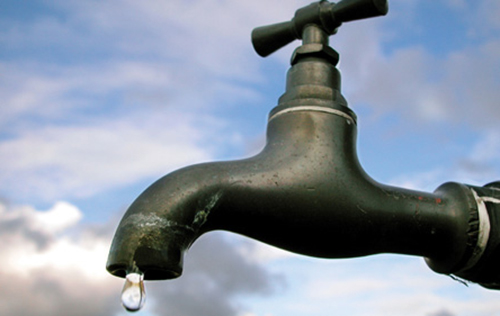Water tanks, tarps, and a few pieces of PVC pipe can go along way in a disaster. Simple rainwater harvesting systems are inexpensive and easy to build.

Advanced systems cost more yet do a lot more. How to keep your family alive in the months following a catastrophic disaster.
A large scale disaster can destroy underground pipes throughout the city and a loss of power can cause water companies to close their doors as water plants cease operation. In a mega-disaster, these plants may be completely destroyed, public water now a thing of the past.
Suddenly, there’s no more water coming from your tap or any water that does come from faucets may no longer be safe to drink due to contamination by chemicals, sewage, or worse.
A disaster, such as a nuclear meltdown or detonation of an atomic weapon, can release massive amounts of radiation into the air; when it falls to the surrounding countryside, radiation can poison reservoirs as well as aquifers (underground bodies of water that supply several regions with drinking water).
Prepping for Water Shortages
If you’re going to prep for disaster, wouldn’t it be wise to have a source of drinking water not connected to the water company?
Using a mix of primitive technology and modern day technology — you can have a source of drinking water — through rainwater harvesting.
If you have the finances, you can purchase large water tanks that can be stored underground and out of sight, providing water for drinking, washing, and bathing in a time of emergency or collapse.
Prep by Collecting Empty 5 Gallon Jugs
If you don’t have the finances, that’s ok — there are several creative ways to collect rainwater as it falls on your home and property and then bottle and store it for later use.
The least expensive way to prep for a disaster is to gradually build up a collection of empty 5 gallon water jugs, the jugs commonly seen on the top of water coolers, as well as sold (and recycled) at stores in several communities.
Empty jugs are light weight — if you lack storage space, consider storing these in your attic. Or, if you live in an apartment or condo without an attic, be creative. Lift your bed frame two feet off the floor (purchase some lumber from your local hardwood store) and then build a storage area right under your bed. You may be able to store 20 empty five gallon jugs right under your bed. If you take the time to think, you’ll probably find additional creative spaces to store empty water jugs, even if you don’t think you have the extra space.
Now you’re much more prepared for a catastrophic disaster — you’ll have a system ready for harvesting rainwater, and supplying your family with drinking water, much like what is found in a number of third-world countries today.
Recycling / Storing Tap Water in 5 Gallon Jugs
Tip: There’s no telling when the first rainstorm will occur following a disaster. Today, consider filling a number of these 5 gallon jugs with tap water. Then, every six months or so, dump the water out and refill your jugs (water can go “bad” after a few months of storage). That way your water is relatively fresh, should a disaster not take place for several months after you begin your water storage preps.
So, that is how you store water on a budget, and prepare yourself for surviving a catastrophic disaster.
Or, if you own your own home and you have the finances, you can hire a company to build a professional rainwater harvesting system.
Companies that Specialize in Rainwater Harvesting
Companies that specialize in rainwater harvesting systems can supply all of the components you might need while others perform complete installations such as building roofs (metal roofs), providing back-up generators, and even include a first flush filter chamber that automatically disposes of the first few gallons of water collected following a storm, as the first few gallons usually carry dirt and other sediment that’s collected on a roof since the last rain storm.
What if you don’t have the finances for one of these advanced system? Good news — there are simple, inexpensive ways to also harvest rainwater. Even if you do purchase an advanced system and have it installed at your home or property it’s a good idea to learn how these simple systems work because there’s always a chance your advanced system will be destroyed in a major disaster.
Without a back-up plan for collecting water, what will you do?
Water Tanks
Water Storage Tanks
Once these first few gallons of rainwater are dumped by a first flush system — to reduce the fine particles of dirt — rainwater then collects in a water tank (or multiple water tanks, depending on the size and scope of your system), where it is then stored. A good, sturdy corrugated steel water tank makes a great choice for large storage requirements.
If your water tanks are full when a disaster strikes, you’ll have several hundred gallons of water for you and your family to live off.
Then, in the coming weeks as the rain comes down, your water tanks will refill and you will have a constant water supply.
As long as you have fuel for your generator, your pumps will continue to work, and your system will continue to operate.
In the Event of an Extended Disaster – Primitive Rainwater Harvesting
Should a disaster be so widespread that you one day run out of fuel to power the generator to power the pumps that run your rainwater harvesting system, it’s not the end of the world.
Now it’s time to fall back on primitive technology and use techniques used by primitive people in different parts of the world to collect rain water.
These primitive systems require no power, just ingenuity and planning.
Because harvesting rainwater subjects collected water to contaminants from the environment (such as bird dung, insects, polluted air, and even plant debris), often it’s being used to supply water for washing and toilets, rather than for drinking.
(If you want to use this water for drinking, you’ll want to turn to a system of distilling — purifying water by creating steam and collecting condensation — or simply filtering (primitive filtering, with just cloth, sand and charcoal) and boiling.)
Preppers and Simple Methods for Rainwater Harvesting
You, being a prepper — a person who takes steps to prepare home and family for a time of disaster — should take the time to learn a few simple methods for rainwater harvesting. You’ll be a great help to your neighbors in their time of need, as well as have a back-up plan should you have to evacuate the area and leave your large stores of bottled water behind.
Here’s another reason for rainwater harvesting — collecting rainwater will help make any bottled water you have stockpiled last longer.
How a Simple Rainwater Harvesting System Works
Using a Tarp to Collect Rainwater
A surface is turned toward the sky and pointed downward at a slight angle, to a low point, where water that collects then “funnels” to either a bucket or even to a pipe, that then carries the water to a barrel, tank, pond, or underground tank.
A tarp is an easy way to collect rainwater; a larger tarp will collect more than a smaller tarp.
For the cleanest rainwater, every few days clean your tarp, removing any debris or mildew that has formed.
The further away from trees, the better — your tarp will collect less bird dung and also less debris (like leaves and pine needles) that fall.
Use Gutters to Collect Rainwater
Most homes have a natural system for collecting rainwater — gutters. Your gutters will have a series of drains, often on each corner of a home, that then funnel down a second gutter (down-spout), to either be carried away underground, or to simply drain into yards and driveways.
To use this system that is already in place, you simply need to make modifications to the down-pointing gutter, so that it carries water to a barrel, tank, pond, etc.
Using an existing gutter system in this fashion, calls for taking some steps before hand. Take the time to clean and repair your gutters; keep them clean with periodic maintenance.
Stockpile a few large tarps; in a time of disaster you can drape 2 – 3 large tarps over the roofing of your home, allowing rainwater to collect on the tarp and then drain into your gutters.
Avoiding Contaminants
This is going to provide you with cleaner water than if it simply lands on your rooftop, which is likely to have environmental contaminants (like bird dung or even mildew or algae, depending on climate).
Because of mosquitoes, build “closed-loop” systems. This means that once water hits a gutter, it doesn’t collect and pool, offering mosquitoes a place to breed. Instead, the water should drain immediately to a down-spout, and then collect in sealed barrels or tanks.
** In areas of trees, use screens over your gutters (“gutter screens”) to help prevent things like leaves, seeds, and pine needles from washing down into barrels or tanks.
** Periodically clean barrels and tanks of any sediment that has collected or algae that has formed.
Rainwater Harvesting for Potable Drinking Water
To prep for a time of disaster or other extended emergency, keep roofing materials on hand that are safe to use for potable drinking water. I’m referring to sheets of plastic or metal used commonly on sheds and sometimes homes that do not contain toxins or heavy metals (talk to manufactures and even experts in the rainwater harvesting field who build roofs for this purpose). Most traditional roofing materials such as tiles, shakes, cement, wood, or others have ingredients that will leech into water. This water is not good for anything other than washing and for toilet water.
If you want a rainwater harvesting system for potable drinking water, be sure to choose a type of roof such as uncoated stainless steel or factory-enameled galvanized steel with a baked-enamel, certified lead-free finish.
You can of course build your home with a complete roof that is made specifically to provide potable water through rainwater harvesting. Be ready to shell out several thousand dollars.
Simple, Portable System
Or you can build a rainwater harvesting system that’s a lot cheaper and a lot more portable. I’m talking about tarps — though there is one thing to consider when it comes to tarps. Somebody might take your tarps right off your roof while you sleep one evening, so you may want to have a few back-up tarps for your back-up tarps. (Thankfully large tarps range in size from $20-$30 typically.)
High-winds can also take your tarps right off your roof. Learn how to use bricks and string to tie several anchor points to any tarp you use on your roof. You can also tie string to several grommets, and then bolt these ties to the side of your home, but in strong enough winds these grommets can tear free. In this case, look for “heavy duty” tarp. It’s much stronger than many types of typical store-bought tarp.
If for any reason you have to evacuate or relocate eventually, tarp rolls or folds up for easy transport.
Rainwater Harvesting from a Tarp Shelter
* Temporary shelters can be built from tarps that provide a method of rainwater harvesting. Hang your tarp at an angle so that water drains off to one side.
* Then build a makeshift gutter out of three long three branches by tying them together, with about 2 inches of space between each branch. Then use another tarp or roll of plastic to wrap these branches in.
* Arrange the sticks inside the tarp so that you have a channel (depression) in the tarp that will now catch water, much like a roof-top gutter.
* Set it at the base of your tarp, where water drains off. It will drip down on to this makeshift gutter and then drain down to a bucket or other container you’ve set up for capturing water.
In an Area Devastated by an Earthquake, Tornado, Tsunami, or Hurricane
A neighbored destroyed by a natural disaster will offer numerous materials that can be used to harvest rainwater. Use a hammer and saw to pry and cut into walls where you can cut away pipes used to carry water (small diameter pipes carry clean drinking water to sinks … don’t use larger diameter pipes that carry “greywater”; which is waste water from sinks, dishwashers, washing machines, and shower drains) or toilet water. Use these pipes you’ve scavenged in conjunction with tarps you’ve stockpiled.
** Better yet — along with those tarps you’re prepping with, stockpile a number of PVC pipes that are used in plumbing for drinking water (any Lowes or Home Depot will have them). They’re inexpensive, light-weight, and can be used in any primitive rainwater harvesting system you build.
** While we’re on the subject of materials to prep with, be sure to stockpile a few rolls of duct tape, or as much as a few cases. Duct tape can be used in large amounts to tape together pipes (be sure to have pipe joints, which there are different types, for connecting pipes together at different angles).
** If you have to relocate to a new area (because your area is no longer safe to live), a primitive rainwater system can be easily broken down and moved (depending on the size and number of tanks you have to carry).
Water Tanks and Freezing Temperatures
Protecting Water Tanks from Deep Cold
Water tanks used in northern states or at higher elevations (such as a cabin or property in the foothills or mountains) can be subject to freezing temperatures for days or weeks at a time. Water tank heaters are the solution, however they require power to operate.
Going into winter, if you’re counting on your water tank supplying you with drinking water for several weeks at a time, there are different methods for keeping water in your tanks from freezing, when there is no power.
* Start by purchasing insulating blankets that wrap around water tanks, or build insulation yourself (in a mega-disaster you’ll be surprised at just how much debris from destroyed homes and buildings can be found, such as wall and attic insulation, which you can collect).
* Use Styrofoam or other insulation (along with plenty of duct tape, to keep insulation in place) to keep valves and pipes from freezing.
* On water tanks, use insulated lids as the lid is an area that heat can escape.
Using the Sun
* When kept full of water, your tank can stay warm enough for several hours to get the tank through the night without freezing. This is the rule of thumb in areas receiving plenty of sunshine as the sun shining on a tank (above-ground tank) during the day can warm the tank enough that (when full of water) it can get through the night without freezing.
* When placing a water tank above ground, place in an area on your property that receives the most sunshine. You may need to cut down a couple trees that otherwise block the sun.
* Cover tanks with black tarp; when the sun shines on black tarp, it warms the air underneath, creating more warmth around your water tank.
* Tanks can also be buried beneath homes and accessed by cellars. The ground beneath homes is typically warmer when a “heat island” is created, which is a natural occurrence.
When There is No Sun
* In areas without much sun, bury below-ground tanks beneath the frost line, which can be as deep as 60 inches in northern states. (The frost line is the depth where ground above it is frozen, and ground beneath it is not.)
* Finally, in areas without direct sunlight, build tanks alongside outside fireplaces, or whatever system you use to heat your home or shelter or to cook with. Arrange bricks so that heat from a fireplace or fire-pit can warm a water tank without damaging it.
Source: secretsofsurvival.com
_____________________________________________________________________________________
OTHER USEFUL RESOURCES!
Blackout USA (EMP survival and preparedness guide)
Bullet Proof Home (A Prepper’s Guide in Safeguarding a Home )
Backyard Innovator (All Year Round Source Of Fresh Meat,Vegetables And Clean Drinking Water)
Conquering the coming collapse (Financial advice and preparedness )
Liberty Generator (Easy DIY to build your own off-grid free energy device)
Backyard Liberty (Easy and cheap DIY Aquaponic system to grow your organic and living food bank)
Family Self Defense (Best Self Defense Strategies For You And Your Family)
Sold Out After Crisis (Best 37 Items To Hoard For A Long Term Crisis)
US Water Revolution (Generate Your Clean Water Anywhere)
Alive After The Fall (Key Survival Situation Procedures and Knowledge )
Mega Drought USA:(Discover The Amazing Device That Turns Air Into Water)



